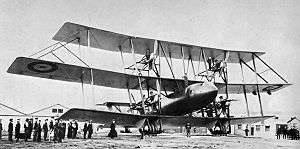Tarrant Tabor
The Tarrant Tabor was a British triplane bomber designed towards the end of the First World War and was briefly the world's largest aircraft. It crashed, with fatalities, on its first flight.
| Tabor | |
|---|---|
 | |
| Role | Bomber |
| Manufacturer | W.G Tarrant Ltd |
| Designer | Walter Barling |
| First flight | 26 May 1919 |
| Primary user | RAE |
| Number built | 1 |
Development
The Tabor was the first and only aircraft design produced by W.G Tarrant Ltd, a well-known property developer and building contractor at Byfleet, Surrey, which had been subcontracted to build aircraft components during the First World War. In late 1917 Tarrant assembled a design team, led by Walter Barling, hired from the Royal Aircraft Factory and Marcel Lobelle, hired from Martinsyde to design a very large long-range heavy bomber, capable of bombing Berlin.[1][2]

Construction was primarily in wood with conventional tri-plane strut-braced wings and a monocoque fuselage built up from ply veneers.[3]
The Tabor was originally planned as a biplane powered by four 600 hp Siddeley Tiger engines. However delays in development of the engines[note 1] meant these would be unavailable and so the aircraft was redesigned to use six 450 hp Napier Lion engines to give a similar power/weight ratio, and a third, upper wing added.[4]
The final design had a wingspan of over 131 ft (40 m), with the central wing of much greater span than the other two. Four engines were mounted in push pull configuration pairs between the lower and middle wings with the other two mounted in tractor configuration between the middle and upper wings, directly above the lower pairs. The tractor engines used two-bladed propellors, the pushers four-bladed ones. With the end of the war conversion to a passenger aircraft was planned.
The monocoque construction gave a large open space within the fuselage. The pilots were situated in the nose, with a partition separating them from the engineer's station and the engine controls mounted on either side of the opening in the partition.[5] The fuel tanks were in the top and sides of the fuselage to maintain the clear internal space.

Work on the aircraft had stopped at the end of the First World War, when it was no longer needed as a bomber. It was later completed with the design altered to allow it to be used as a commercial or transport aircraft.[6]
The Tabor's maiden flight was from the Royal Aircraft Establishment at Farnborough on 26 May 1919. The Tabor, with two pilots and five passengers was taxied around the landing field using only the four lower engines. Satisfied with the behaviour of the aircraft the crew decided to take-off.[6] The tail was off the ground but it was still running on the main wheels, intermittently lifting off. When the top two engines were started the aircraft pitched forward, burying the nose into the ground and seriously injuring all on board.[6] The second pilot died after reaching hospital and the pilot died of his injuries a few days later.[6][7]
Later analysis suggested that the upper engines were so far above the fuselage that they forced the nose down when driven up to full power. The situation may not have been helped by the addition of 1,000 lb of lead ballast in the nose against the wishes of Tarrant.[4]
Specifications (estimated)
Data from The British Bomber since 1914[4]
General characteristics
- Crew: Six
- Capacity: 9,000 lb load as passenger aircraft
- Length: 73 ft 2 in (22.31 m)
- Wingspan: 131 ft 3 in (40.02 m)
- Height: 37 ft 3 in (11.36 m)
- Wing area: 4,950 sq ft (460 m2)
- Airfoil: RAF 15
- Empty weight: 24,750 lb (11,250 kg)
- Gross weight: 44,672 lb (20,305 kg)
- Fuel capacity: 10,000 lb (4,500 kg)
- Powerplant: 6 × Napier Lion W-12 water-cooled piston engine (four tractor, two pusher), 450 hp (336 kW) each
Performance
- Maximum speed: 96 kn (110 mph, 177 km/h)
- Range: 1,043 nmi (1,200 mi, 1,932 km) estimated with 10,000 lb fuel and 9,000 load[3]
- Endurance: 12 hours
- Service ceiling: 13,000 ft (3,970 m)
- Time to altitude: 33 min 30 sec to 10,000 ft (3,050 m)
- Wing loading: 9.02 lb/sq ft (44.1 kg/m2)
- Power/mass: 0.06 hp/lb (0.099 kW/kg)
Armament
- Bombs: approximately 4,600 lb planned
See also
- Witteman-Lewis XNBL-1 - a design by Barling for a similar aircraft for the US Army
References
- Notes
- the Tiger would not run until 1920 and the project was cancelled
- Citations
- Prins 2019, p. 61
- Mason 1994, p. 126
- "The Tarrant Giant Triplane". Flight. XI (19): 592. 8 May 1919. No. 541. Retrieved 12 January 2011.
- Mason, Francis K (1994). The British Bomber since 1914. London: Putnam Aeronautical Books. pp. 126–127. ISBN 0-85177-861-5.
- Flight p630
- "Triplane Wrecked at Farnborough - Capt P.T. Rawlings Killed". News. The Times (42110). London. 27 May 1919. col D, p. 9.
- "Tarrant Triplane Pilot's Death". News in Brief. The Times (42112). London. 29 May 1919. col A, p. 9.
- Mason, Francis K (1994). The British Bomber since 1914. London: Putnam Aeronautical Books. ISBN 0-85177-861-5.CS1 maint: ref=harv (link)
- Prins, François (February 2019). ""The big machine is not safe to fly"". Aeroplane. Vol. 47 no. 2. pp. 60–64. ISSN 0143-7240.CS1 maint: ref=harv (link)
- "The Tarrant Giant Triplane". Flight. Vol. XI no. 541. 8 May 1919. p. 592. Retrieved 12 January 2011.
- "The Tarrant Giant Triplane, the "Tabor"". Flight. Vol. XI no. 542. 15 May 1919. pp. 626–632. Retrieved 12 January 2011.
- "The Tarrant Triplane". Flight. Vol. XI no. 544. 29 May 1919. pp. 702–703. Retrieved 12 January 2011.